It has been 3 days since my last post.
It is now Election Day. This is my last pre-election post.
I usually do some sort of post-election post-mortem, but usually not until at least when the Electoral College does in December, but maybe not until after January 6th, or maybe not even until I start setting things up for the next election cycle, which may be a couple of years. So don't hold your breath. It all depends if I have time and if I feel the inspiration. 🙂
For anybody interested, my Curmudgeon's Corner cohost Ivan and I will be live streaming our reactions as the vote counting unfolds tonight over at the Curmudgeon's Corner YouTube channel. We expect to start at 0 UTC. That's 7 PM Eastern, 4 PM Pacific. Join us!
Four and eight years ago I live blogged results here as they came in. I won't be doing that this year. There are better sources of live return information. Pick your favorite. I might post some updates or thoughts over at @ElectionGraphs@newsie.social on Mastodon if you want to check in on that.
As of 20 UTC (3 PM Eastern, Noon Pacific) I closed the books on adding new polls to Election Graphs for 2024. If there are any more straggler polls, sorry, they won't be included. Everything in this post now reflects the final state before polls start to close.
One last TL;DR, which should look very familiar:
Harris's position overall has improved since three days ago (the tipping point went from Trump by 0.5% to Trump by 0.1%), but the overall situation is the same as it has been for over a month.
If the polls are underestimating Trump right now, he wins.
If the polls are underestimating Harris right now, she wins.
If the polls are close to right, then it all comes down to Pennsylvania, which could go either way.
Any outcome from Harris winning by 100 electoral votes to Trump winning by 86 should not be considered surprising.
This reflects all seven of Wisconsin, Michigan, Pennsylvania, Georgia, North Carolina, Nevada, and Arizona having poll averages so close that either candidate winning is easily in the realm of the possible.
If you restricted the whole analysis to only the highest quality pollsters, the tipping point would change from Trump by 0.1% to Trump by 1.0%. So this time the lower quality polls actually make things look BETTER for Harris, not worse. But either way, the race is still in the zone where it could go either way. Picking and choosing which polls you like and which ones you don't doesn't really change this.
The "Uniform Swing" Election Graphs model, which is the one I expect to be closest to true, currently gives Trump a 63.6% chance of winning, to Harris's 36.4%. These percentages take the fact that final polling from 2008 to 2020 in close states has underestimated the Republican more often than not, so figures that is more likely than not to happen again.
But there are now various possible indications and hints that there might be a systemic underestimation of Harris even with the high quality pollsters. But that may or may not end up playing out that way. We'll only know once the votes are counted.
OK, now time for more details here are the usual changes since last time:
Here is the new spectrum of states with margins under 10%:
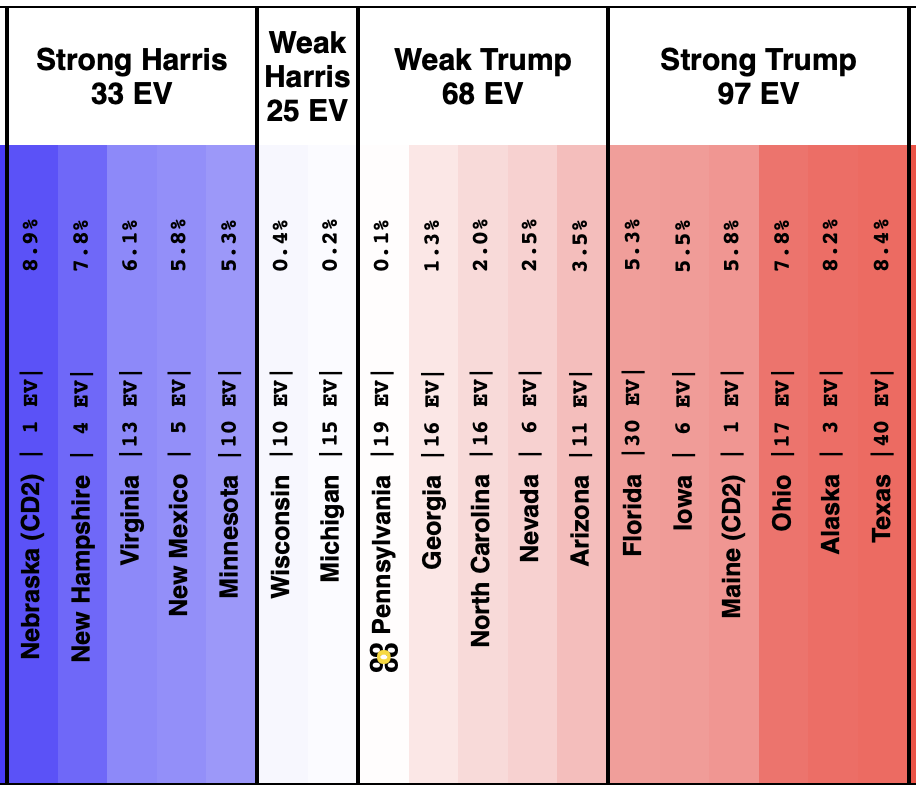
Comparing to the status in the post from 3 days ago:
Moved toward Trump:
- Arizona (11 EV): Trump by 2.1% -> Trump by 3.5% (Trump+1.4%)
- Ohio (17 EV): Trump by 6.5% -> Trump by 7.8% (Trump+1.3%)
- Nevada (6 EV): Trump by 1.8% -> Trump by 2.5% (Trump+0.7%)
- Iowa (6 EV): Trump by 5.0% -> Trump by 5.5% (Trump+0.5%)
- North Carolina (16 EV): Trump by 1.7% -> Trump by 2.0% (Trump+0.3%)
- New Mexico (5 EV): Harris by 6.0% -> Harris by 5.8% (Trump+0.2%)
- Wisconsin (10 EV): Harris by 0.5% -> Harris by 0.4% (Trump+0.1%)
No movement:
- Nebraska-CD2 (1 EV): Harris by 8.9%
- Michigan (15 EV): Harris by 0.2%
- Alaska (3 EV): Trump by 8.2%
- Texas (40 EV): Trump by 8.4%
Moved toward Harris:
- Georgia (16 EV): Trump by 1.4% -> Trump by 1.3% (Harris+0.1%)
- Pennsylvania (19 EV): Trump by 0.5% -> Trump by 0.1% (Harris+0.4%)
- Maine-All (2 EV): Harris by 9.9% -> Harris by 10.4% (Harris+0.5%)
- Minnesota (10 EV): Harris by 4.7% -> Harris by 5.3% (Harris+0.6%)
- Maine-CD2 (1 EV): Trump by 6.4% -> Trump by 5.8% (Harris+0.6%)
- Virginia (13 EV): Harris by 4.5% -> Harris by 6.1% (Harris+1.6%)
- Florida (30 EV): Trump by 7.3% -> Trump by 5.3% (Harris+2.0%)
- New Hampshire (4 EV): Harris by 3.3% -> Harris by 7.8% (Harris+4.5%)
Pretty mixed bag, with states bouncing around in both directions. No clear trend, but the tipping point moved from Trump by 0.5% in Pennsylvania to Trump by 0.1% in Pennsylvania, just to leave things just about as close at they could possibly be.
As before, let's also look at the recent trends in each of the 7 key states rather than just the final values, to see where these states have tended to be lately and how volatile the averages have been.
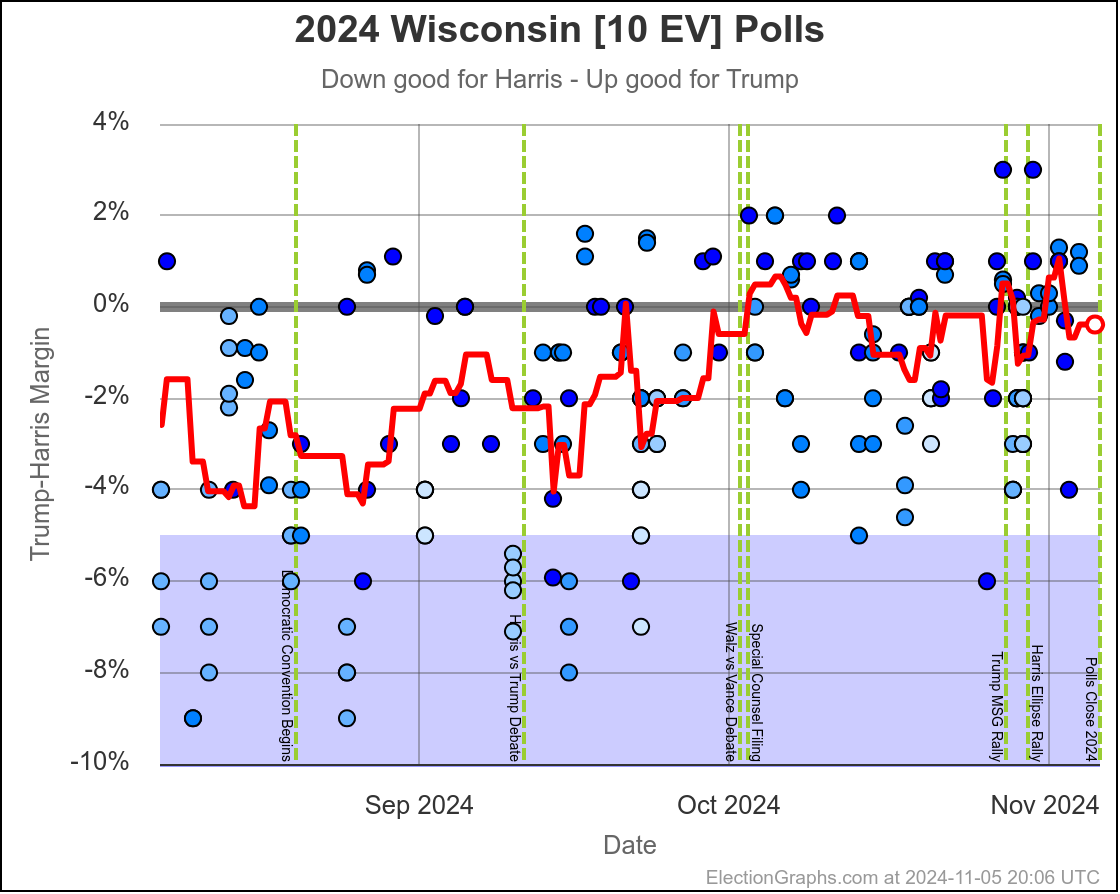
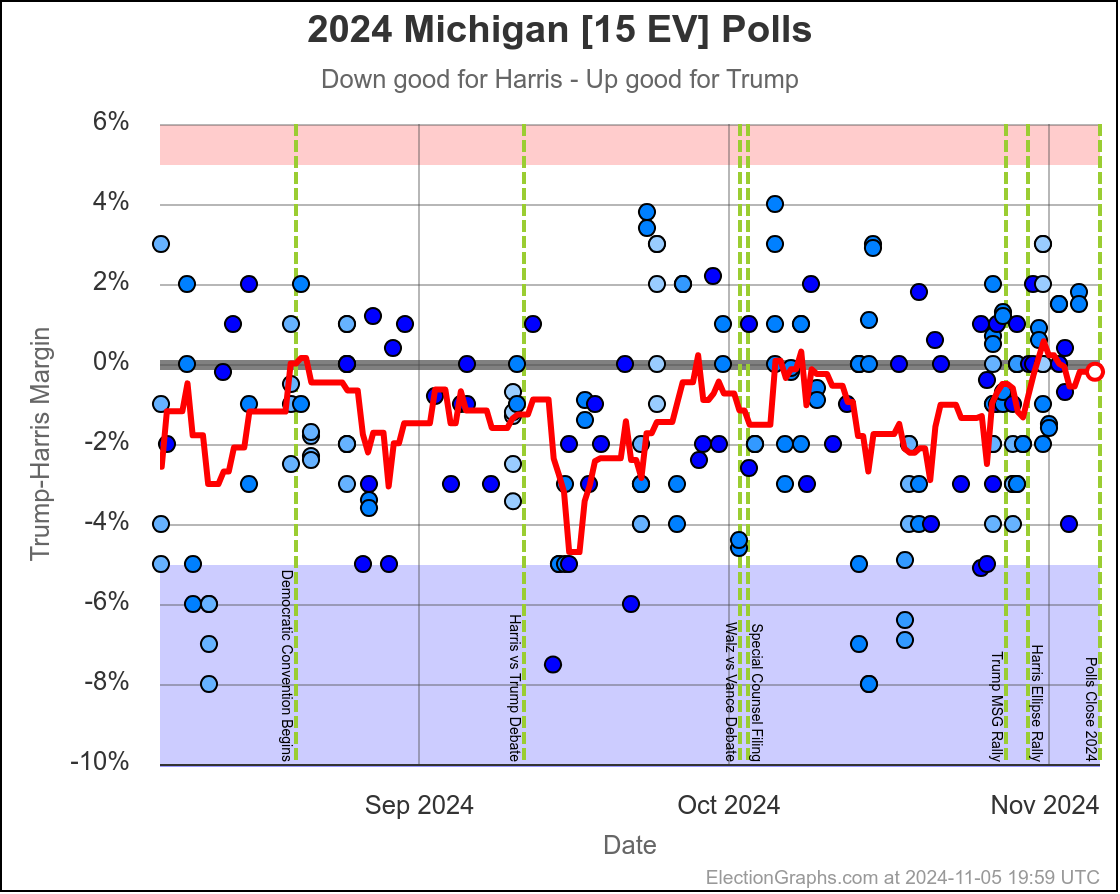
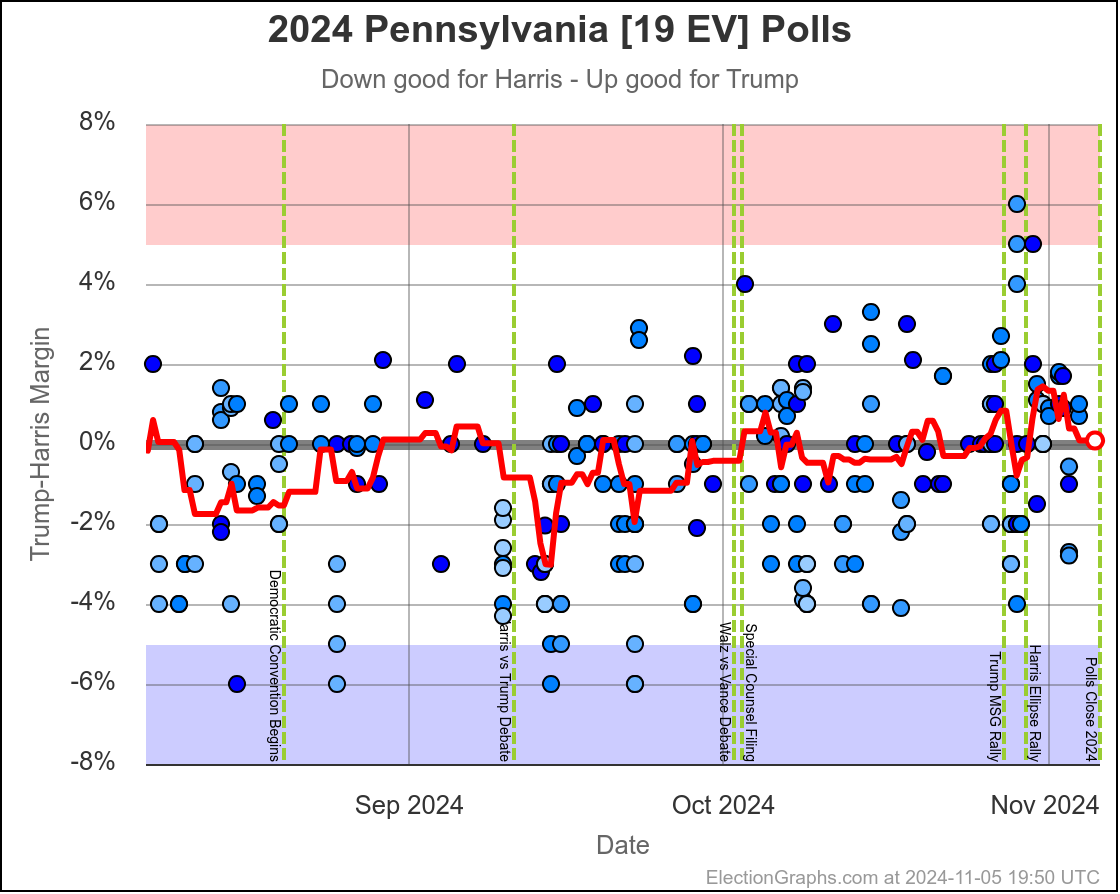

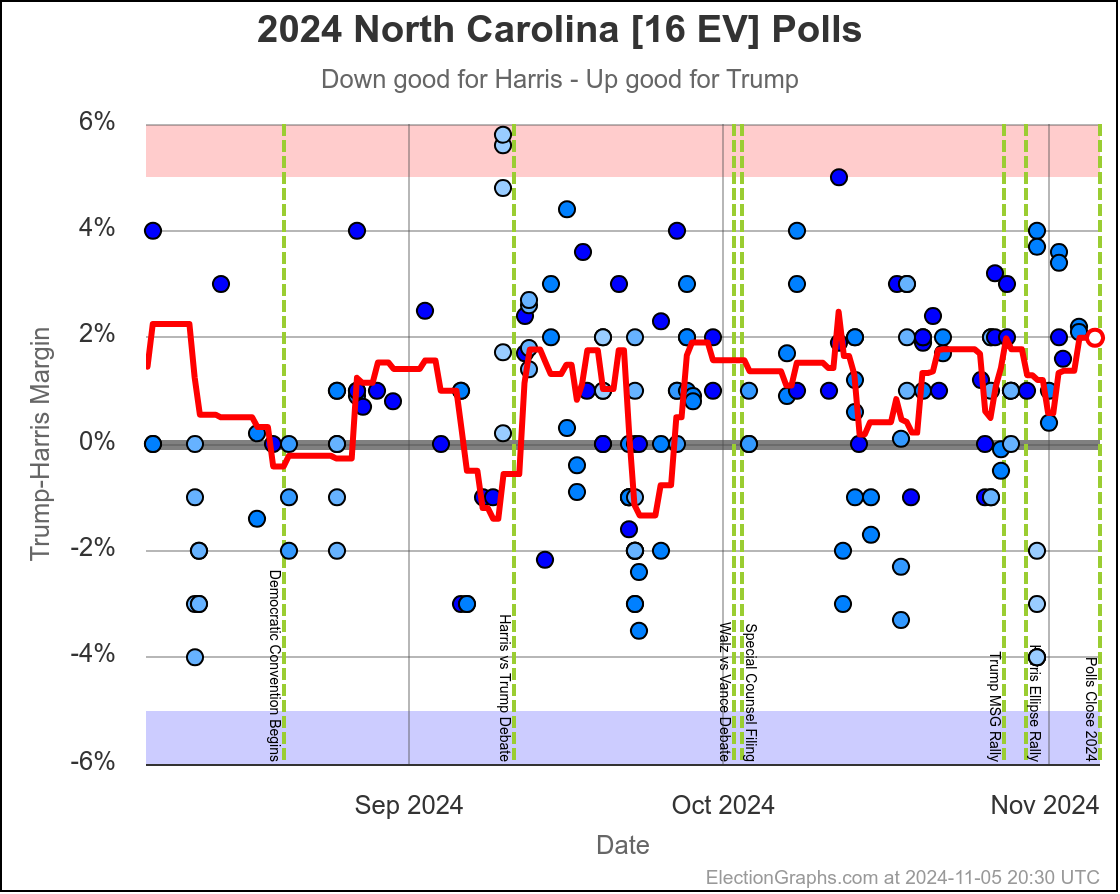
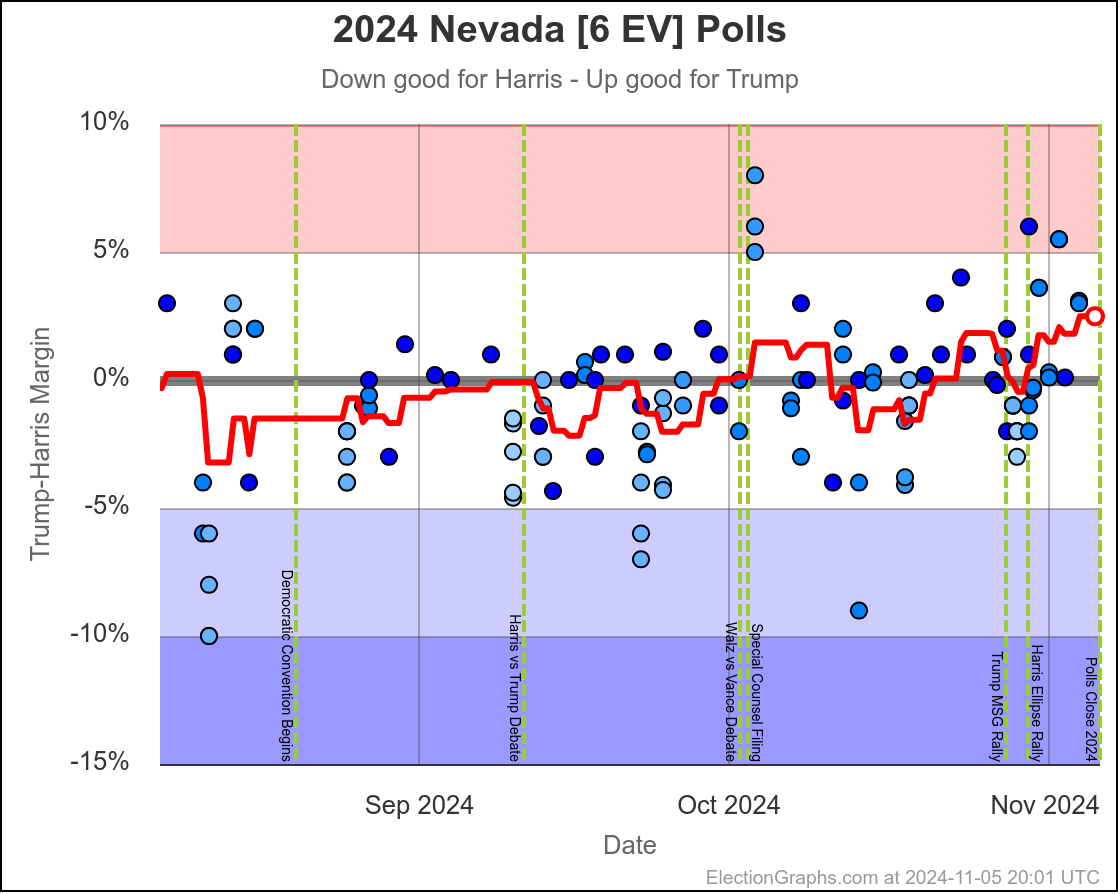
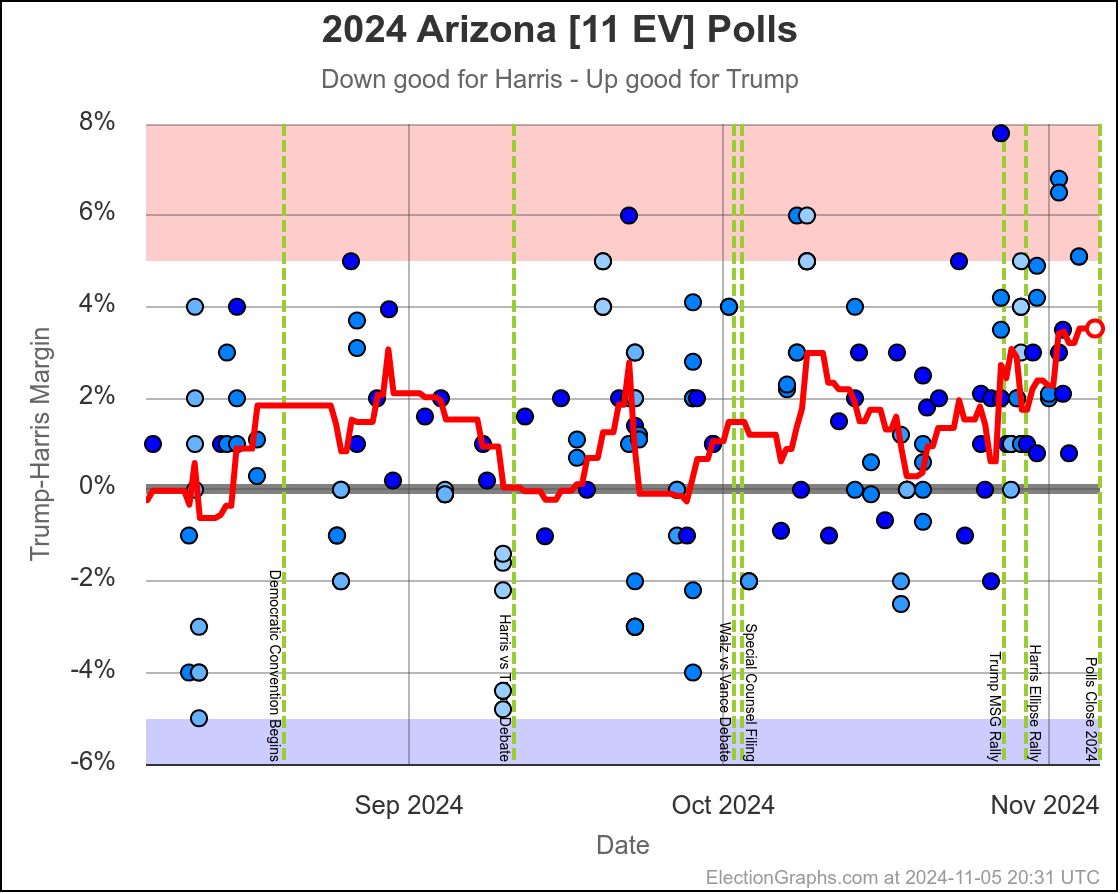
Bottom line on all of these, taking the polls at face value… so not worrying for the moment about systematic bias, or pollsters actively trying to influence the averages, I would classify the states like this:
True toss up: Wisconsin, Michigan, Pennsylvania
Probably Trump: Georgia, North Carolina, Nevada, Arizona
I'd previously put Wisconsin and Michigan at Probably Harris, but they look less so now.
We'll look at how restricting the averages to high quality pollsters only looks in a moment, but first lets look at how all this motion in the states translates into an overall national situation:
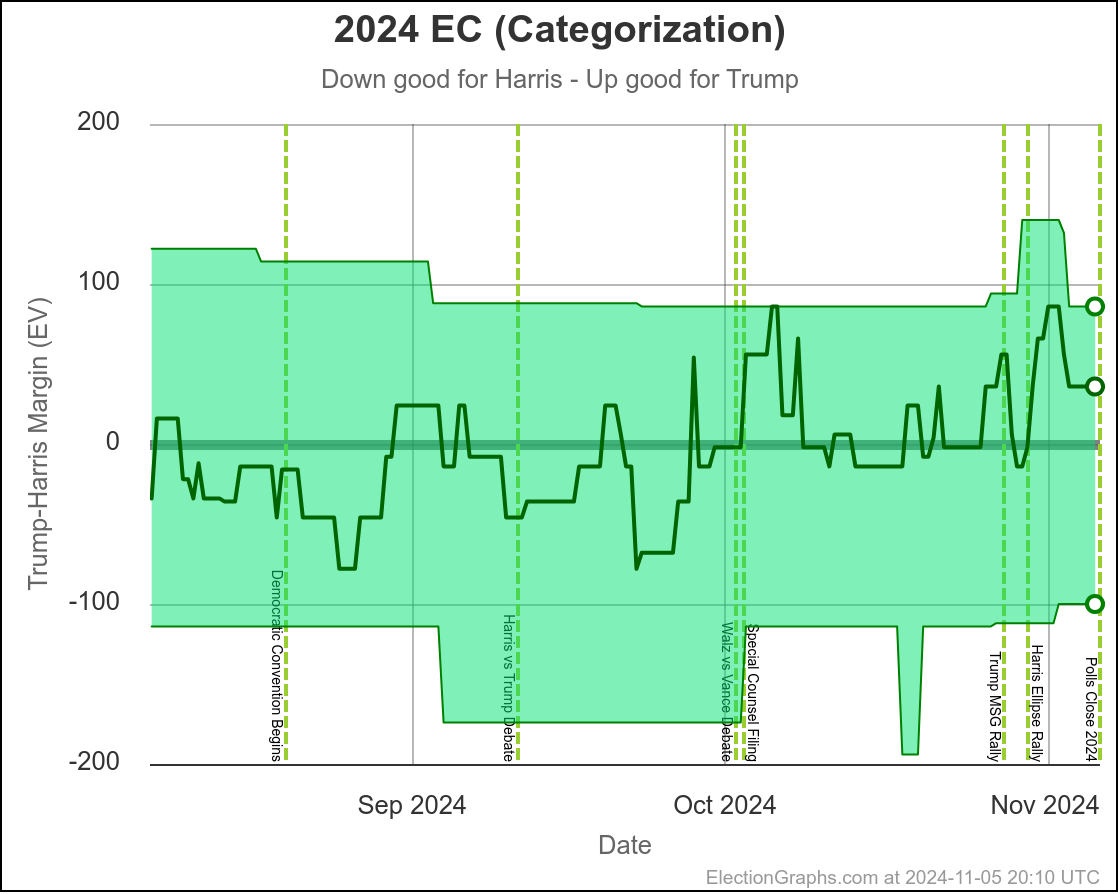
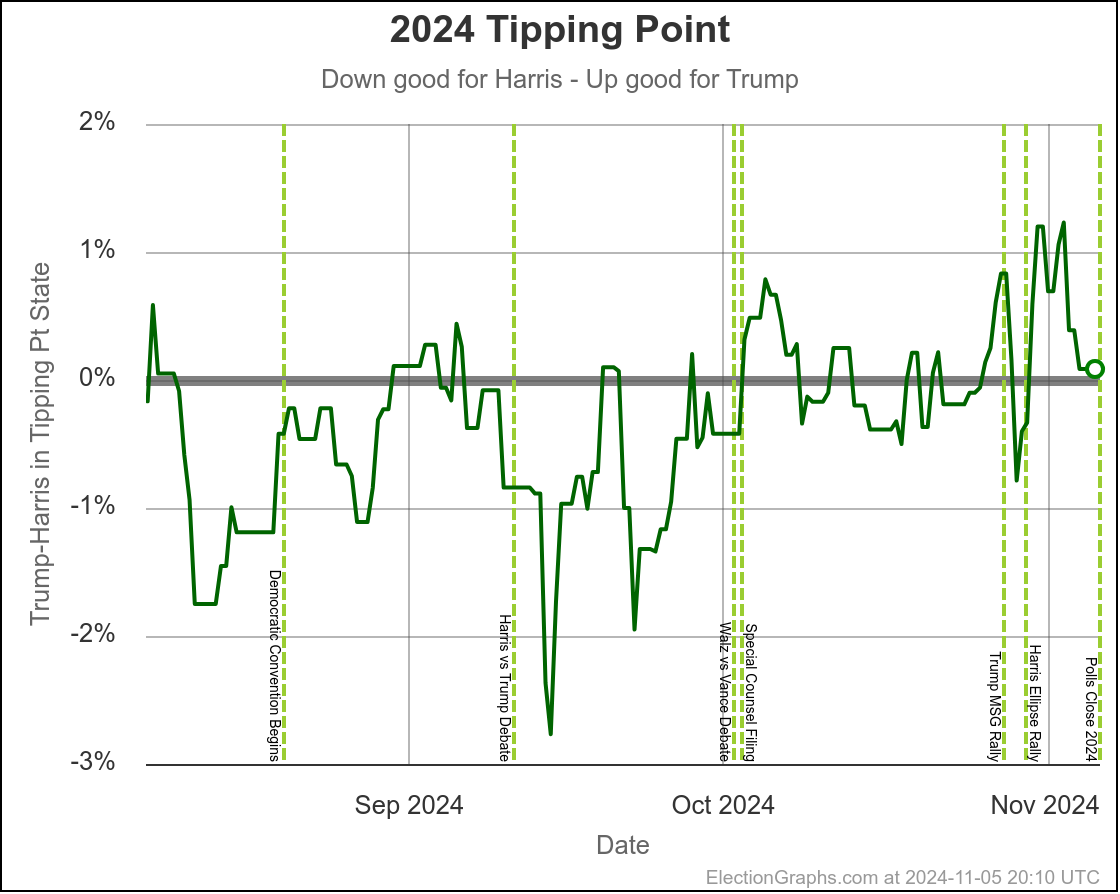
The envelope of the possible has stayed pretty stable for a long time. The tipping point chart is the one to look at, and basically it has just been bouncing around the zero line for a little over a month. This just tells us it is close. Which has been the theme forever.
So let's look at my probabilistic models. Well, specifically lets look at the "Uniform Swing accounting for time left" model, because I think of the four, this is going to end up being the right one to look at, as I expect polling errors between states will be pretty correlated. That is, if pollsters are systematically missing something, or even if "junk pollsters" are gaming the averages, they will likely be doing so in the same direction across all the close states.

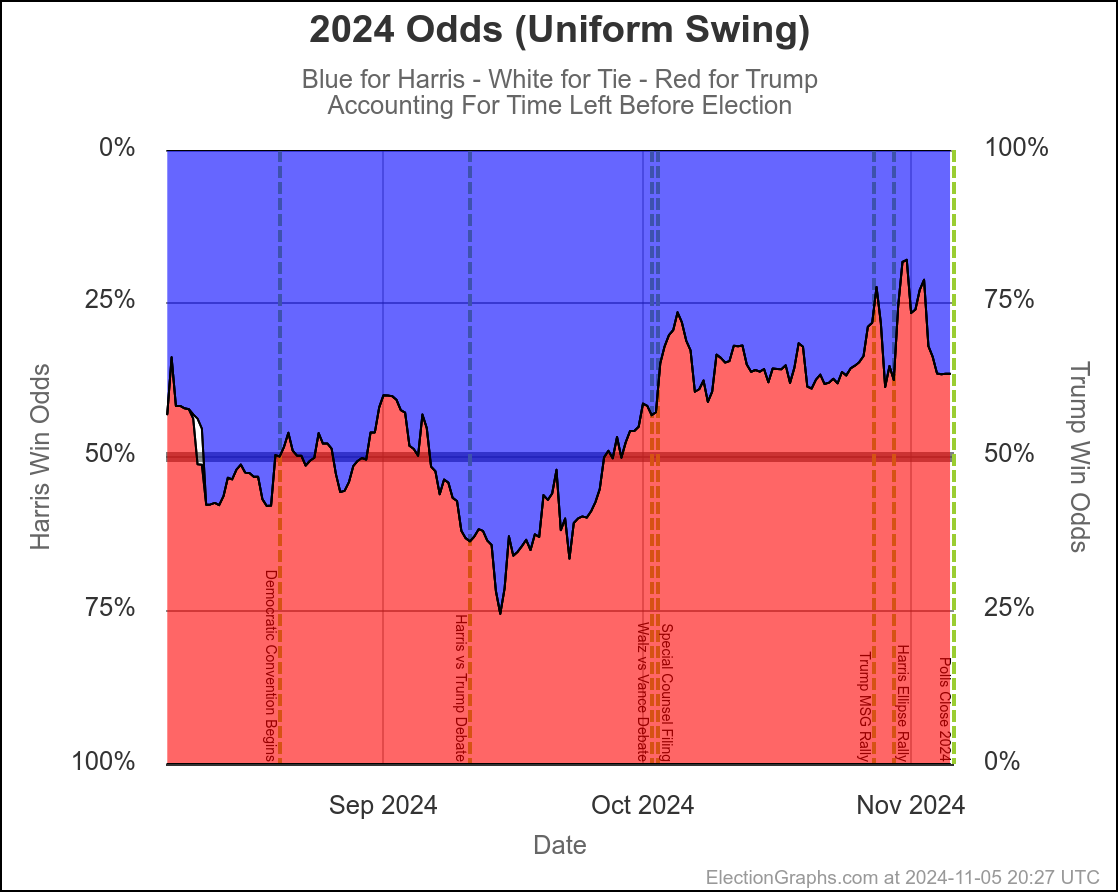
Just drawing a trend line and ignoring short term spikes, we've been roughly in the same situation for the last month. About 35% Harris, 65% Trump.
And this makes sense with the tipping point bouncing around the tie line for the last month, plus the fact that for the past 4 election cycles polls have underestimated Republicans more often than not. This is the main reason my odds for Harris are lower than other places, which anticipate polling error, but ignore the previous direction of those errors.
The others right now:
I'll add that Election Betting Odds (not based on polls, but on aggregating betting sites) currently has her at 41.2%.
So let's look at potential places where polls could be off here. The first thing that lots of people have talked about in the last few weeks is that "junk pollsters" (usually partisan) were flooding the averages and poisoning the results for anybody aggregating polls like we do.
First of all, they did this in 2020 and 2016 too, so this isn't new. And the polls still underestimated Trump in both those cycles. But this is still a good exercise.
So here is a table showing what the averages look like with All Polls (what EG does), vs if you restricted it to only polls with a 538 Pollster Rating of 2.5 or above. Also, by special request of my Curmudgeon's Corner cohost Ivan, another version further removing Atlas Intel, who he finds suspicious despite being rated highly by 538.
|
All Polls |
Rating>2.5 |
No Atlas |
| Wisconsin |
Harris+0.4% |
Harris+0.0% |
Harris+1.8% |
| Michigan |
Harris+0.2% |
Trump+0.8% |
Harris+1.2% |
| Pennsylvania |
Trump+0.1% |
Trump+1.0% |
Trump+0.2% |
| Georgia |
Trump+1.3% |
Trump+1.2% |
Trump+0.4% |
| North Carolina |
Trump+2.0% |
Trump+1.4% |
Trump+0.1% |
| Nevada |
Trump+2.5% |
Trump+2.4% |
Harris+1.1% |
| Arizona |
Trump+3.5% |
Trump+4.5% |
Trump+3.1% |
So there is some movement in both directions, but the tipping point (in bold) remains Pennsylvania, and Trump remains ahead by a small margin using all three ways of selecting which pollsters to include.
Unlike the last time I did this analysis, the lower quality pollsters are actually HELPING Harris by moving the tipping point 0.9% in her direction. If you remove the lower quality pollsters AND remove Atlas, the tipping point still moves 0.1% toward Trump.
But regardless of any of that, the overall picture does not change. You still have 7 states with margins that are smaller than the typical polling error in recent elections. Let alone if we have an unusually large poll error.
There has been a lot of talk that polls may be systematically underestimating women and overestimating non-college whites, because A) nobody was fully accounting for female anger over Dobbs, and B) pollsters were overcompensating for their misses in 2016 and 2020. This may well be the case. But we won't know until the votes are counted. There might be an error in the other direction too.
So you still have a situation where any one of these seven states could end up going to either one of the two candidates. And therefore so could the whole election.
So. Guess you just have to watch the election results as they start to come in shortly. We'll find out when we find out. The polls have only told us that they are unable to predict the winner.
As I said at the beginning, anything from Harris winning by 100 to Trump winning by 86 should not be surprising.
So here is my final map:

Parts of a couple of states have already closed their polls as I finish this blog post. The first full states close in less than 30 minutes. And then we start getting actual vote counts.
Again, my Curmudgeon's Corner cohost Ivan and I will be live streaming our reactions as the vote counting unfolds tonight over at the Curmudgeon's Corner YouTube channel. Starting in just a few minutes. Tune in!
And thank you all for following Election Graphs this cycle! See you again when it is time to ramp up for the 2028 cycle!













